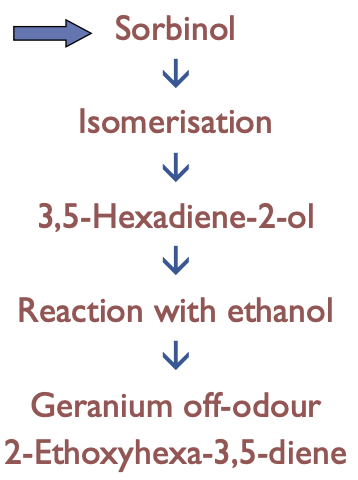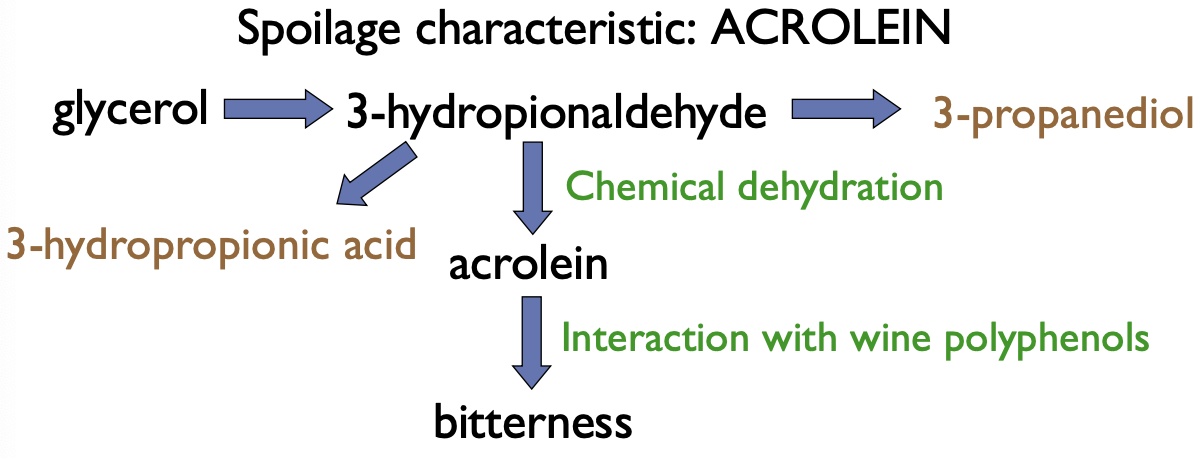Bacterial spoilage
1/17
There's no tags or description
Looks like no tags are added yet.
Name | Mastery | Learn | Test | Matching | Spaced |
|---|
No study sessions yet.
18 Terms
What types of wine spoilage organisms are there?
yeast - aerobic and fermentative
bacteria - LAB, acetic acid bacteria (AAB) other
fungi - botrytis other
What is the definition of wine microbial spoilage?
imparting an off-aroma or flavour to wine or cause a change in the physical appearance of a wine (e.g., haze)
What is the impact of growth of spoilage microorganisms on wine composition?
microbiological faults diminish the acceptability of the finished wine therefore QUALITY
changes occur in wine depending on which organism develops
What are some examples of bacteria involved in wine spoilage?
LAB - Lactobacilli
AAB
Pediococcus
In the metabolism of hexoses, what is involved in homofermentative species of bacteria?
Hexoses fermented via glycolytic pathway with pyruvate being reduced by lactate dehydrogenase to lactic acid.
Almost entirely lactic acid (>80%), trace of acetic acid, ethanol and carbon dioxide.
2 ATP/hexose molecule
In the metabolism of hexoses, what is involved in heterofermentative species of bacteria?
Sugar metabolized via alternative pathway (phosphoketolase pathway).
Multiple products; acetic acid, carbon dioxide, glycerol, ethanol, acetaldehyde and lactic acid (<50%).
1 ATP/hexose molecule
How does acidification occur in wine spoilage?
due to production of acetic acid and D-, DL- or L-lactic acid
produced by heterofermmentative species of lactobacillus, lentilactobacillus and oenococcus from glucose (acetic acid plus L- or D-lactic respectively)
produced from homofermentative species of lactobacillus, lactiplantibacillus and pediococcus from pentoses (no acetic acid produced, DL or L-lactic)
wines with residual sugar (CRITICAL FACTOR) are at GREATEST risk (particularly wines setting on lees - potential nutrients)
may also occur during AF if there is delay in onset of yeast activity
generally also associated with high pH (CRITICAL FACTOR)
What is mannitol taint? And how is it formed?
due to enzymatic reduction of fructose
produced by heterofermmentative bacteria - e.g., L. brevis
associated with elevated acetic acid, D-lactic acid, n-propanol, 2-butanol
associated with ropiness and diacetylmorphine
wine tastes viscous, acetate-esterish
OCCURS IN WINES WITH
HIGH RESIDUAL SUGARS AND HIGH pH
*CRITICAL FACTORS*
How does ropiness/increased viscosity occur in wine spoilage?
due to production of extracellular polysaccharides - D-glucan: slimy texture
important factors are:
strain (e.g., P damnosis, resistant to ethanol and SO2)
glucose
lack of agitation, high biomass and nitrogen availability
trait is mediated by a plasmid, therefore STRAIN SPECIFIC
associated with high acetic acid and mannitol taint and becomes evident after MLF
controlled by pH and SO2
How is excessive diacetyl produced?
buttery/butterscotch impact
generally >4mg/L considered faulty
produced during MLF either:
during hexose/pentose utilisation
during citric acid metabolism, during MLF by O. oeni
may be removed by post-fermentation treatment with S. cerevisiae (or further aging on yeast lees)
How are mousy off-flavours produced?
flavour reminiscent to aroma of caged mouse
only detected after the wine has been swelled takes seconds to build - off-flavour lingers
considerable variation in the sensitivity between individuals
due to production of N-heterocyclic compounds
2-acetyltetrahydropyridine - associated with bread and corn chip aroma
2-ethyltetrahydopyridine
2-acetylpyrroline - associated with jasmine rice aroma
implicated bacteria include: L. brevis, L. cellobiosis, L. hilgardii
requires ethanol, amino nitrogen: L-lusine and/or L-ornithine
associated with high pH and low SO2 wines
other microbes too
What is involved in the degradation of tartaric acid?
associated with wines already spoiled and where other acids (citric, pyretic, malic) have been metabolised: results in DEACIDIFICATION
rare spoilage as limited to a few strains of L. plantarum (Mech I) and L. brevis (Mech II)
associated with high pH wines
acetic acid (>3 g/L) produced

How is geranium off-odour produced?
related to metabolism of sorbic acid by LAB
sorbic acid is reduced to sorbinol by Oenococcus
NOT pediococci or lactobacilli
low odour threshold: 100 ng/L
only in wine, as need ethanol
only add sorbic acid to wines with LAB is not expected
sensory threshold 100 ng/L

What is involved in glycerol catabolism?
a principle yeast metabolite
ranges in concentration (5-8 g/L)
important sensory effects
bacterial activity can breakdown glycerol; important consequences
LAB
AAB
What is the typical spoilage characteristic produced by LAB and glycerol?
Bitterness
important factors:
strain
low glu and fru
oxygen (potentially)
more likely in red wine
pH and SO2

Generally speaking, what are AAB and what do they cause?
Gram negative rods
– Acetobacter
– Gluconobacter
– Gluconoacetobacter
cause high volatility acidity (acetic acid may react with ethanol, forming ethyl acetate)
KEY FACTOR: AEROBIC GROWTH
At what stages is AAB problematic?
on damaged grapes (particularly in association with botrytis)
primary fermentation (if sluggish)
post-primary fermentation processing (during conservation period of MLF) and storage
mousy off-flavour
What is the relationship between AAB and glycerol?
AAB degrade glycerol via dihydroxyacetone
sweet/etherish sensory properties, binds to SO2
further reaction with proline to produce ‘crustlike’ sensory character
not all species
inhibited by ethanol, therefore, typically related other botrytis affected grapes